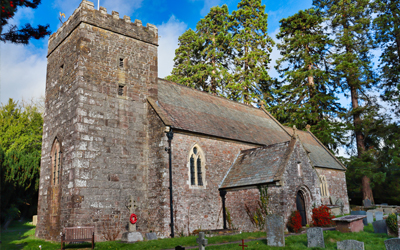St Deiniol, Itton

Services
2nd Sunday of the month: Liturgy of the Word - 11.30am
4th Sunday of the month: Holy Communion - 11.30am
(for details of this month’s services, and festivals, click here...)

2nd Sunday of the month: Liturgy of the Word - 11.30am
4th Sunday of the month: Holy Communion - 11.30am
(for details of this month’s services, and festivals, click here...)
Contact Details:
Priest - Fr Michael Gollop SSC - 01291 622064, frmichaelgollop1@gmail.com
Churchwarden - Mrs Elaine Cavill - cavillelaine8@gmail.com
Churchwarden - Professor Bruce Matthews - b.matthews@bristol.ac.uk
PCC Secretary - Mrs Anne Octon - anneocton@gmail.com
Treasurer - Mr Kevin Higgs - kdhiggs007@gmail.com
Church in Wales Page: Visit the page »
Address: St Deiniol, Itton, Chepstow, NP16 6BR
There has been a place of worship on this site for over fourteen hundred years, when a church was established here in the 6th century by Deiniol Wyn, first Bishop of Bangor. It was also mentioned in a papal bull of 1133. Those were the days of early Celtic Christianity, followed by the Church of Rome. Anglican worship came probably in the late 16th century.
The earliest parts of the present building, the lower tower, the porch, the chancel arch, and possibly some of the roof trusses, date from the latter part of the Middle Ages. They feature characteristics of the simple Early English Gothic style.
Little is recorded of the building from then until the 19th century, but there are tombstones in the church, and in the burial ground, dating from the 1700s. During that time, and up to 1956, the church’s principal benefactors were the Curre family, who lived at Itton Court. Their coat of arms can be seen in the porch, and above the chancel arch, bearing the motto “Gratus si amicus” (“You are welcome if you are a friend”).
The next major development was in 1869, the date on the rainwater heads, and was overseen by the famous Victorian architect Henry Woodyer. His work includes the grilled openings on either side of the chancel arch, the vestry, the carved wooden altar rail, the stone and alabaster reredos with an inlaid black marble cross, the stone pulpit, the octagonal stone font, the stained glass windows, and the installation of the pews. The latest addition to the church is ITTON 2000, the Millennium Embroidery, which depicts many of the buildings and aspects of our village.
We have one bell, made in 1702 and 36 inches in diameter. It was cast at the Chepstow Foundry by Evan Evans, and is the largest of the four bells this foundry made for our local churches (the others were for Kigwrrwg, Penterry and St Arvans). Inscribed on the surface is “God Bless Queen Anne William Fordes C warden EE 1702”. Electricity was installed in the church as early as 1894, by the Curre family, at the same time as they introduced it to Itton Court. It was probably the first church in Monmouthshire to have electricity, and the Pontypool Free Press reported that “the effect is pleasing”.
The unusual organ, a manual, was built in the Low Countries some time between 1690 and 1703, initially for a Bristol merchant’s home. Later it was moved to Clearwell Castle, then in the 1870s the Curre family bought it for St Deiniol’s. One unusual feature is a nag’s head swell mechanism. Damage by mice was repaired in 2006 by Roger Taylor.

The Organ
We have two churchyards and are minimising grass cutting in the older of the two, which directly surrounds the church, in order to help, encourage and protect wild flowers and wildlife. We have recently undertaken substantial repairs to the fabric of the church, including the tower, roof and guttering.